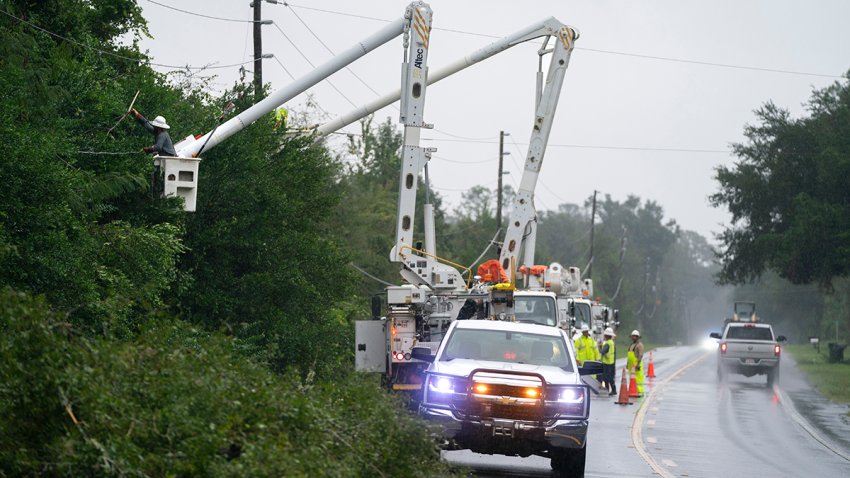John Morales is the longest tenured broadcast meteorologist in South Florida, serving as a reassuring television presence for nearly three decades. His tropical weather acumen and steadfast character guided South Florida viewers through hurricanes Andrew, Irene, Katrina, Wilma, and most recently Hurricane Irma. For his life-saving work during the 2017 season, Mr. Morales was recognized with the John Coleman Broadcast Award at the National Tropical Weather Conference.
Born in Schenectady, New York of an Irish-American father and a Puerto Rican mother, John was raised in Puerto Rico and later returned to his roots in Upstate New York to attend the atmospheric sciences program at prestigious Cornell University. In college, John won the student weather forecasting contest, rowed for the Cornell Crew, and later worked as a disc jockey and sportscaster for student-run radio station WVBR.
After graduation in 1984, John became a civil servant with the U.S. National Weather Service, where he became a Lead Forecaster in Puerto Rico before accepting a position as Chief of the South American Desk at the National Center for Environmental Predictions in Washington D.C.
His first TV job was at the Univision Network and its Miami station WLTV channel 23, where he served as Chief Meteorologist from 1991 through 2002. From 2003 through 2008 he served as Chief Meteorologist for WSCV Telemundo 51. While there, he became the first Latino to substitute as meteorologist on NBC’s Weekend Today show, and did so multiple times. In 2009 John Morales became Chief Meteorologist for NBC’s Miami station WTVJ / NBC6, where he still serves today.
John Morales is one of very few weather presenters elected to be a Fellow of the American Meteorological Society (AMS). In what could be considered his most important scientific recognition, John earned the 2007 AMS Award for Outstanding Contribution to the Advance of Applied Meteorology. Among his many credentials, John holds the AMS and National Weather Association Seal of Approval for Radio and TV weathercasting, and has won the Broadcaster of the Year Award from both organizations. In addition, he is accredited by the AMS as a Certified Consulting Meteorologist and a Certified Broadcast Meteorologist. He has won three regional Emmy Awards, one at each station he has worked in. Most recently, Mr. Morales was presented with the Silver Circle Award, in recognition of the quality of his contributions to television.
In 1997, Morales participated in Vice President Al Gore’s White House conference on global warming and climate change. John returned to the White House at the invitation of President Barack Obama in 2014 for the release of the Third National Climate Assessment. He has twice been appointed to National Academies of Sciences (NAS) committees, co-authoring studies in 2012 and 2017 pertinent to America’s Weather Enterprise. He also wrote Huracanes, a Spanish-language reference book on hurricanes in 2000.
Morales’ volunteerism extends from board of directors’ participation in multiple South Florida non-profits, to mentoring young scientists, to having piloted for Angel Flight Southeast, an organization that provides free flights so children and adults can have access to far-from-home doctors. John and his wife Carmen live in Coconut Grove.
The Latest
-

John Morales: Human-caused ocean warming fueled recent hurricanes, study says
Ocean temperatures made higher by human-caused climate change are fueling more intense hurricanes in the Atlantic.
-

John Morales: A never-ending hurricane season and the good news for Florida
One more for the road? … this unending hurricane season had to deliver one more surprise in its waning days.
-

Rafael rips through Cuba before chugging into Gulf of Mexico: John Morales
Rafael brought a life-threatening storm surge, damaging hurricane-force winds, and flash flooding to parts of western Cuba as it made landfall in the province of Artemisa.
-

1 month to go: John Morales on where this season stands and 3 areas to watch
When it comes to hurricanes, Floridians’ spirits lift in November. The end of the season is in sight. While a November storm can never be ruled out — see 2022’s Hurricane Nicole — the chance of being struck by a hurricane drops rapidly as we march towards Thanksgiving.
-

John Morales: NOAA debunks claims about modifying the weather, creating hurricanes
In the subheading, NOAA cut to the chase: “No one creates or steers hurricanes; the technology does not exist.”
-

John Morales: Fears of backloaded hurricane season materialized in awful way in Florida
Fears of a backloaded hurricane season materialized in an awful way in the past few weeks. Hurricanes Helene and Milton collectively claimed hundreds of lives. And each hurricane is estimated to have produced at least $50 billion in damage.
-

Morales: Calamity-filled weeks show importance of dispelling weather conspiracies
Humans can change some aspects of the weather. Science-based weather modification techniques are now employed in over 50 countries according to the World Meteorological Organization. But for every science-based weather-altering technique, there are dozens of pseudoscientific urban legends.
-

A monstrous Cat 5: Milton's rapid intensification explained by John Morales
Last year, Hurricane Otis struck very near Acapulco, Mexico, as a monster 165 mile-per-hour category 5 cyclone. About 24-hours before landfall, the National Hurricane Center (NHC) was predicting it would do so as 70 mile-per-hour tropical storm. With the energy content (and destructive potential) of the wind increasing with the cube of the windspeed, that means that Otis reached Mexico…
-

Helene leaves behind apocalyptic scenes, a humanitarian catastrophe that's still unfolding
No one can hide from the truth. Extreme weather events, including hurricanes, are becoming more extreme.
-

Historic Hurricane Helene larger than 90% of tropical cyclones: John Morales
Mean Helene is on a mission to be yet another multibillion-dollar disaster.


